Floppy Disk Container
From Homestar Runner Wiki
Bleu Ninja (Talk | contribs) (Rewording to delineate IRL/in-universe (and get rid of "presumably", one of my wiki-phrasing bugbears)) |
(→Floppy Disks) |
||
| Line 354: | Line 354: | ||
|-id="vampire's_castle" | |-id="vampire's_castle" | ||
| [[File:FloppyVapire'sCastle.png|150px|Vampire's Castle]] || [[Disk 4 of 12 - Vampire's Castle]] | | [[File:FloppyVapire'sCastle.png|150px|Vampire's Castle]] || [[Disk 4 of 12 - Vampire's Castle]] | ||
| - | ||'''''Vampire's Castle''''' is a 1984 game for DOS. It is a short adventure game where the titular vampire's castle must be explored to uncover "concealed goals" and ultimately kill the vampire before midnight. Descriptions in the game are bare, and there are few actions that can be performed.<br/>In [[video games#Commentary Transcript|the commentary]] for [[video games]], The Brothers Chaps mention it as an influence on [[Thy Dungeonman]] | + | ||'''''Vampire's Castle''''' is a 1984 game for DOS. It is a short adventure game where the titular vampire's castle must be explored to uncover "concealed goals" and ultimately kill the vampire before midnight. Descriptions in the game are bare, and there are few actions that can be performed.<br/>In [[video games#Commentary Transcript|the commentary]] for [[video games]], The Brothers Chaps mention it as an influence on [[Thy Dungeonman]], a fact corroborated in-universe when Strong Bad declares it was "definitely" Videlectrix's inspiration for the Thy Dungeonman game.|| [https://www.mobygames.com/game/vampires-castle-adventure MobyGames] |
|} | |} | ||
Revision as of 11:28, 12 May 2023
The floppy disk container sits on the right of Strong Bad's computer desk while he checks emails. The majority of the labels are names of computer games (although several Nintendo Entertainment System and Atari 2600 titles also appear), and most are obscure titles from the '80s and '90s. This has become a running joke, and although the first Floppy Disk Container appeared in the email little animal, the disks were not labeled until ghosts. They are usually labeled in red marker, though in some of the early appearances, they were labeled in blue. The Brothers Chaps sometimes comment on the featured game in their DVD commentaries. The series Strong Bad's Disk 4 of 12 features Strong Bad playing these games.
This page catalogs the appearances of the floppy disk container. Each section has an image, the name of the toon(s) or email(s) in which it appeared, a brief explanation of the game mentioned on the floppy disk, and sources of supplementary material about said game.
Floppy Disks
| Image | Appearances | Explanation | Sources |
|---|---|---|---|
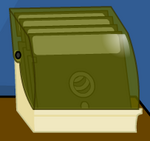 | little animal, superhero name, do over (in the do over of sisters), candy product and isp | 5.25 inch disks were a standard computer media format in the 1970s and early 80s. The term 'floppy' was coined for their similar but even larger 8 inch predecessor, as one could easily bend the disks enough to nearly fold them over without breaking them, a trait shared by the 5.25 inch disks. The 5.25 floppy disk was also featured in technology, outside of the Floppy Disk Container. They were superseded by 3.5 inch floppies by 1988; in modern computing, methods such as USB drives or cloud storage have become the standard for data storage and sharing. | Wikipedia Howstuffworks |
 | ghosts, 50 emails | Tongue of The Fatman was a 1989 fighting game for DOS and Commodore 64 that was later ported to the Sega Genesis as Slaughter Sport. Different alien races (including Human) could be chosen to use, who all had different abilities and fighting styles. The player could purchase weapons and devices and fight his way through multiple opponents to face the Fatman, Mondu. Some of the more innovative features include being able to place wagers on the outcome of the fight and the phenomenon of a special move becoming less powerful the more it was used to balance gameplay. Unfortunately, the game was plagued by unresponsive controls and an overly high difficulty. | Wikipedia MobyGames GameFAQs |
 | morning routine, cheat talk | Lode Runner was a strategy game for DOS, Apple, and Commodore 64, originally created in 1983, with a later port by Hudson being one of the first third party games on the Famicom. It was originally an ASCII art game, where Jake Peril, the main character, was simply a $ sign (The enemies were ¶'s). The object of the game was to win back treasures stolen by the Evil Empire. It was eventually re-released on the Apple II as Miner with much more advanced graphics. Miner was submitted to Brøderbund and was finally published, under the name 'Lode Runner'. Countless versions of this game have been made and circulated over the Internet. | Wikipedia MobyGames GameFAQs |
 | current status | Loom was an adventure game for the PC and TurboGrafx CD, released in 1989. It was one of a variety of games created by Lucasfilm Games. Bobbin Threadbare, the mysterious "Loom child" and member of the Weaver Guild, must embark on a perilous journey to follow his guild members, who were turned into swans and flew away from the Loom island. All puzzles are solved using a variety of spells cast from a magical staff, with no traditional inventory. The game was not actually released on 24 disks; this is actually a reference to the "Stump Joke" from another famous LucasArts game The Secret of Monkey Island, where the user would be prompted to "insert disk 24" which did not exist. Loom was actually released on six 5.25" disks or three 3.5" disks; it was also later released on CD-ROM. | Wikipedia MobyGames GameFAQs |
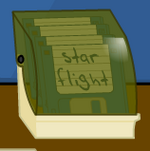 | huttah! | Starflight was a ship game created by Electronic Arts for the PC and the Sega Genesis, released in 1986 and 1991, respectively. Mankind has left earth due to an exhaustion of resources and needs to colonize another planet. The player travels around the galaxy mining, gathering crew, fighting aliens, and trying to figure out why star systems are being blown up, without getting blown up along with them. | Wikipedia MobyGames GameFAQs |
 | interview | Rise Of The Dragon was a puzzle game for DOS, Amiga, and Sega CD, released in 1990. It was presented in a Blade Runner-like environment and story. Ex-cop William "Blade" Hunter is contracted to root out the source of a deadly new drug, MTZ, that ships in patch form and has a tendency to turn users into lizard creatures before killing them. A few arcade sequences are featured, which can be skipped if the player dies a certain number of times. | Wikipedia MobyGames GameFAQs |
 | unused emails, Disk 4 of 12 - FriendlyWare, Disk 4 of 12 - FrienDendum | FriendlyWare was a software package for the PC, released in 1987. It was released by Friendlysoft, written in BASIC, and rendered in text mode via clever use of ASCII art characters. The games included Master Mind, Nevada Dice, Killer Maze (navigate 3D mazes), Sea Battle (find a submarine with depth charges), Boggy Marsh (find monsters in a marsh), Hangman, Tic-Tac-Toe (unbeatable against computer), Wildcatter (an oil drilling simulation), Othello, Peg Leap (basic remove pegs game), Blackjack, Dominoes, Golf, Head Coach (a football simulation), Match (a Memory-style game) and Towers of Atlantis (a Tower of Hanoi game). Other software included a number of financial programs, eye and ear tests, an ASCII art drawing program, a biorhythm charter (which suffers from the Y2K bug), sports prediction software, and a computing tutorial. | Wikipedia |
 | Arcade Game, caper | Manhunter: New York is a first-person point-and-click adventure game for DOS, Atari ST, and Amiga, designed by Dave, Barry, and Dee Dee Murry, and published by Sierra On-Line in 1988. In the then-future year of 2002, the Orbs, an alien race composed of enormous eyeballs, invades the planet Earth, mainly New York. Two years later, in 2004, the player assumes the role of a Manhunter whose only job is to track down human criminals and bring them to justice. | Wikipedia MobyGames GameFAQs |
 | big white face, Disk 4 of 12 - World Games | World Games was a sports game for DOS, Commodore 64, and the NES, made in 1987. It was made by Epyx, a company that made mainly sports games. World Games was a collection of sports games from around the globe. In addition to entertainment value, it was also educational as each event started with an informative introduction screen that gave both the background of the sport and the basic rules. Some of the more enjoyable games included the Scottish Caber Toss and Spanish Bull Riding. | Wikipedia GameFAQs |
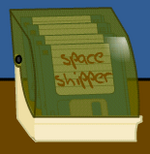 | privileges | Space Shipper is a fictitious game made by Videlectrix, and looks to be a Gradius/1943-esque shooter. Fiendish lasers threaten to destroy the solar system! Explosions are taking over the galaxy!! It's Memorial Day and YOU were the only Spaceshipper who didn't have plans. Pilot your StarZoom to freedom! And time and a half!! | Videlectrix |
 | funny | Odell Lake was an educational life-simulation arcade game for the Apple II, released in 1986. It was created by MECC, a company known for making many educational games. It was a simulation game in which the player takes the role of a fish in Odell Lake, Oregon. The fish meets various forms of animal and plant life, including other types of fish. Each time the fish meets another animal or a plant, he must decide what to do. His decisions determine whether or not he survives. | Wikipedia GameFAQs Mobygames |
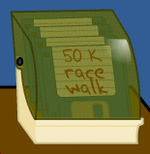 | sibbie | 50K Racewalker is a game made by Videlectrix, programmed by Jonathan Howe. The aim of the game is to alternate pressing left and right for nearly a full day in order to finish. If the player presses buttons too fast or out of sequence, they will be overwhelmed with an annoying "FAULT" message. According to Videlectrix, "you take a few (million) steps in the game, and you won't (will) be disappointed. Left, right, left, right, left, right, left, right, left, right, right, OOPS! You lose." | Videlectrix Demo |
 | anything | The 7th Guest was a puzzle game for DOS, Windows, and Macintosh, released in 1993 by Virgin Interactive Entertainment, the creators of Shogun. Stauf, a maker of cursed toys, has invited 6 guests to his mansion to unravel the mysteries of the building— the titular 7th guest is the player character. The player has to solve a variety of puzzles. The majority of the game is a puzzle collection, tied together by clips of actors, well-rendered 3D animations, and MIDI sound effects and music on two CD-ROMs. The only instruction to the puzzles is a hint book that will provide two hints and mark the puzzle complete so that the player can continue. The 7th Guest was one of the first games to only be available on CD-ROM, leading many to buy CD-ROM drives just to play the game. | Wikipedia MobyGames GameFAQs |
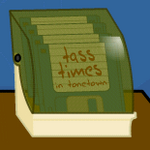 | the process | Tass Times in Tonetown was an adventure game for PC, Apple II, Atari ST, Amiga, and Commodore 64, and was released in 1986. It's a quirky, underrated game made by Activision. The player visits Tonetown, a psychedelic punk rock alternate reality, to save Grandpa from a hideous crocodile creature named Franklin J. Snarl. The player also has the aid of his dog, who not only talks, but becomes a star reporter. The puzzles are numerous, but most are relatively easy. With a world of floating phones, triangular moons, and wacky puzzles all created through Grandpa's dreams thanks to the "dream hoop" he invented, Tass Times in Tonetown is an extremely original game enjoyed by many adventure game fans. | Wikipedia MobyGames GameFAQs |
 | mile | One on One: Dr. J vs. Larry Bird was a pioneering sports game for the Commodore 64 and Atari 400/800, released in 1984. It was one of the first games by Electronic Arts, who would later become famous for their sports games. This basketball game is a faithful translation of the real thing, with fouls and traveling calls, free throws, a three-point line, and even a shot clock. There are a number of gameplay options — play for a certain amount of time or first to a set score, winner's or loser's outs, etc. Players have a fatigue bar that decreases when running around and replenishes when holding still; fatigued players don't move as quickly. It had decent graphics for its time period, but substandard sound effects. | Wikipedia GameFAQs Mobygames |
 | mile | These are blank floppy disks animated by The Cheat. The titles are unseen until clicked on, revealing the titles of the disks in Easter eggs. | |
 | mile (Easter egg) | Out of This World was an action-adventure game for DOS, Windows 3.X, SNES, Atari ST, Amiga, Genesis, Apple Macintosh, and 3DO, originally released in 1991. Lester, the main character, is a young physics professor who suddenly finds himself on a strange alien world after lightning strikes his particle experiment. It's a cinematic game featuring realistic vector graphics and animation. It has plenty of animated cutscenes and ambient sound effects, despite fitting on a single 5.25" disk. The original title is Another World, but Out Of This World was its US release name to avoid confusion with an unrelated TV series; modern rereleases typically return the title to Another World. | Wikipedia MobyGames GameFAQs |
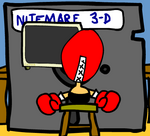 | mile (Easter egg) | Nitemare 3D was an action game, obviously 3D, released for DOS and Windows 3.X in 1994. It was made by Gray Design Associates, a company not known for much other than this game. It's linked to the Hugo House of Horror series in that the main character is Hugo and he attempts to save a girl, Penelope. He wanders through a three-dimensional house of horrors defeating all sorts of evil things in a first-person environment. | Wikipedia MobyGames GameFAQs |
 | couch patch | The title "Old game" is simply a generic title for an old '80s or '90s game. | |
 | kind of cool | Nobunaga's Ambition was a turn-based strategy game by Koei for the MSX, DOS, NES, SNES, Amiga, Game Boy, and Genesis that was released in 1988. It was set in Japan's "Warring States" period in the 16th century. The player takes on the role of a daimyo such as Nobunaga Oda, a merciless ruler and great strategist, to try to conquer Japan. Through turns, the player manages his armies (recruiting new soldiers, training army, buying weapons etc.), keeps his subjects happy, forms alliances, or plays dirty and hires ninjas to bribe and assassinate. Daimyos die of old age or sickness, giving this game a time limit. | Wikipedia MobyGames GameFAQs |
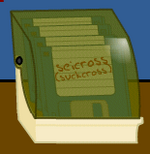 | army | Seicross (also called Suckcross on the disk) is a side-scrolling racing/shooter game for the arcade and NES, released in 1984 by Nichibutsu. On the planet Colura, a peaceful race known as the Petra have been attacked and driven underground by the Basrah, a hostile race. The player's job is to cruise on a hoverbike, the Gilgitt Petras, through numerous terrains to rescue the Petra who are still on the surface. The arcade version features a vertically-oriented screen with objects higher up moving slower than graphics lower down, creating a pseudo-3D effect. | Wikipedia MobyGames GameFAQs |
 | video games | Bio Menace is a classic sidescrolling adventure shooter game for DOS released in 1993. It was created by Apogee, a company known for creating many adventure sidescrollers during that era. When an evil scientist releases a pile of mutants and holds the world hostage, it's up to Snake Logan to save the day. Recently, Bio Menace has been released as freeware by 3D Realms (then Apogee), and can be downloaded from their web site. | Wikipedia MobyGames |
 | lackey | The title of this floppy is obscured by the Flash border, but decompiling the Flash file reveals the title as Maniac Mansion. This was an adventure game for DOS, Apple II, NES, Atari ST, Amiga, and Commodore 64, released in 1987 by Lucasfilm Games. It featured multiple characters to choose from, four possible endings, multiple solutions to the puzzles, and a very non-linear structure in general, giving the player a wide range of methods to win. The plot is to save the girlfriend of one of your characters who's been kidnapped by a mad scientist. The only hurdle is the residents of the Maniac Mansion, as well as the mansion itself. It was made to be a spoof of cheesy action/horror/sci-fi movies of the time. | Wikipedia MobyGames GameFAQs |
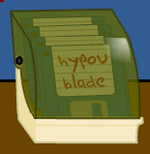 | stupid stuff | Hypou Blade is likely referring to HyperBlade, said with a Homestar Runner speech impediment. HyperBlade was a hockey game released for Windows in 1996. Made by Activision, HyperBlade introduces the 3D battlesport of the future. Players engage in a futuristic street-hockey style game with a very different twist. Body-checks (weapons are included) go for blood in this game as players can be gruesomely eliminated from it. Power-ups, speed boosts, ramps, and simple team management (for substitutions) are all part of the experience. Some strategy is required for play, but it's mostly pure action. It was also one of the first titles ever to make use of the 3DFX graphics card. | Wikipedia MobyGames GameFAQs |
 | different town | BAAL was a little known Action game for the Atari ST and Commodore 64 and was released in 1989. The player is a member of the Time Warriors, an elite commando unit sent into an alien lair to defeat Baal, a crazy demon who is bent on conquering Earth. Featuring grotesque looking aliens, BAAL had a reputation as being a mildly disturbing action game. | Wikipedia MobyGames GameFAQs |
 | Puppet Time | It was revealed on the DVD commentary for Puppet Time that this was The Brothers Chaps' real disk caddy from growing up. Included in the contents are King's Quest II, Police Quest II, and save disks. King's Quest II was an adventure game for DOS, Amiga, Apple II, Atari ST, and PC Booster, released by Sierra in 1987. King Graham searches the land for three keys to unlock the door that will lead to his future queen. Police Quest II was also an adventure game for DOS, Amiga, and Atari ST, released by Sierra in 1988. Jessie Bains, aka The Death Angel, escapes from prison and kidnaps Sonny Bond's girlfriend. Determined to get revenge, he flees the city, leaving a trail of dead bodies as he goes. Bonds must chase after him, leading to a deadly confrontation later on. | King's Quest II Wikipedia MobyGames GameFAQs |
 | flashback, strongbad_email.exe Disc One, The Homestar Runner Gets Something Stuck In His Craw | Cave Quest was an adventure game that The Brothers Chaps made when they were younger, likely in the late 1980s or 1990s. They made it on the Apple II, and it supposedly had "gorgeous low-res Apple II C+ graphics." | Adventuregamers.com (HRWiki mirror) |
 | Strong Bad is in Jail Cartoon | Shogun was an adventure game for DOS, released in 1988. It was made by Virgin Interactive Entertainment, the same company that made The 7th Guest. The player wanders around as one of a number of characters, trying to build up his rapport with the people. If that fails, the player can also battle and plunder, working his way up to the status of Shogun. Items are collectible during the adventure, including weapons and armor. | Wikipedia MobyGames GameFAQs |
 | car | Caveman Ugh-lympics was a sports game for DOS, Commodore 64, and NES (where it was entitled Caveman Games), released in 1988. It was made by Electronic Arts, a company well known for making quality sports games. In this early game of theirs, the player assumes the roles of various cavemen while competing in prehistoric sports, namely Saber Race, Mate Toss, Clubbing, Firemaking, Dino Race and Dino Vault. The controls were somewhat awkward, but with up to a 4-player option (as many as 6 players on the NES using the NES Four Score Adapter), and fun events, Caveman Ugh-lympics made for a short, quirky game. | Wikipedia MobyGames GameFAQs |
 | haircut | Tengen was the home computer and console division of Atari Games. It made games from 1985 through 1993 for a wide array of platforms, from Amiga to ZX Spectrum, and everything in between. Over 40 games were credited to them, with titles such as Paperboy 1&2, Tetris, Indiana Jones, the Temple of Doom, Ms. Pac-Man, Hydra, and many, many more. Tengen never actually released a compilation called "Tengen Classix". | Wikipedia MobyGames |
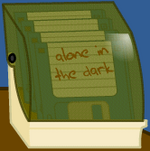 | replacement | Alone in the Dark was an Action Adventure game for DOS and 3DO, released in 1992. Marketed by Interplay as a horror game, it was a 3D adventure game with some action thrown in, loosely based on the works of H.P. Lovecraft. The main character is driven to investigate a "suicide" in an old Louisiana mansion. Little does he know, however, of the lurking horrors that await him. This game features many enemies, few weapons, and one goal: Escape alive. It is the forerunner to many modern day horror games. Resident Evil 1 in particular owes a lot to it in gameplay mechanics, player-view and setting. | Wikipedia MobyGames GameFAQs |
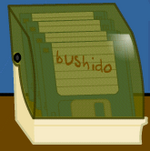 | cheatday | Bushido was an action game for DOS, released in 1983. It was made by Ebenel Enterprises, a company whose best and only credit was Bushido. It was a martial arts fighting game set in feudal Japan with a simple premise: fight a multitude of enemies in a multitude of settings. Very repetitive, but a pioneer of the martial arts fighting genre. In Japanese, bushido means "way of the warrior". | MobyGames GameFAQs |
 | the facts | Thexder was an Action game for DOS, Apple II, Famicom, the MSX and the Amiga, released in 1987. It was a platform shooter from Japan, with many levels and diverse enemies that gradually increase in difficulty. The player pilots a Macross-style robot capable of switching from a mech into a jet at any time, complete with auto-aim, rechargable energy, and a short-term shield that can be activated to protect from harm. It didn't have a save option, however, so long-term play could easily get frustrating. | MobyGames GameFAQs Wikipedia |
 | time capsule | Lunar Lander was an ASCII art game originally played on mainframe consoles. Atari released an arcade game of the same name using vector graphics in 1979. It was later ported to the Atari 400/800 home computers line. The goal of the game was to correctly land a lunar module on the surface of the moon. If the player miscalculates the module's landing, the module will either fly off into space or crash hard against the moon's surface. Due to the simplicity of the design, it has spawned countless Flash copies on the Internet. | GameFAQs Wikipedia |
 | extra plug | Deathtrack was a racing game for DOS, released in 1989. It was made by Dynamix and had a simple premise. In the future, races are held across America where the drivers race for money, and their lives. The main character is a rookie. The player starts the game with a meager sum, but can choose from one of three cars; either speedy, powerful, or armored. The winnings can be used to upgrade the car's armour, weapons and parts to eventually make it nearly invincible — which comes in handy, since this game doesn't really have an ending. | MobyGames GameFAQs Wikipedia
|
 | strongbad_email.exe Disc Two | WOTR Level 2 is likely short for War of the Ring, a Lord of the Rings real-time strategy game for Windows, released in 2003 by Sierra. In this game, the player can choose to lead the forces of Good or Evil as each struggle to control the One Ring. The game is split into two 10-mission campaigns, and follow storylines not focused on in the books or movies. In the Good campaign, the story follows Legolas, Gimli and Boromir as they manage to show up in Rivendell just in time to join the Fellowship of the Ring. In the Evil campaign, the player must lead the forces of Sauron, break out of Mordor and besiege the city of Minas Ithil. This is the newest featured game to date, being at least 10 years later than the next latest release, and was never actually released on floppy disk. The significance of the game being on Level 2 is currently unknown. | MobyGames GameFAQs Wikipedia |
 | strongbad_email.exe Disc Three, strongbad_email.exe Disc Four | Kid Speedy is an arcade-style game by Videlectrix, advertised in 2004 and later released in 2006. According to the product description, everybody is faster than Kid Speedy. In addition, this little fatso is the slowest poke in the bunch. The object of the game is to avoid getting sweets and insults and preventing Kid Speedy from coming in dead last in the race. Since on the third email disc the label was mostly obscured and unreadable, it was re-featured on the fourth disc. | Videlectrix |
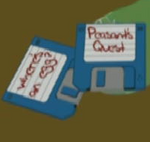 | strongbad_email.exe Disc Three, strongbad_email.exe Disc Five, Homestar Ruiner, Baddest of the Bands | Peasant's Quest and Where's an Egg? are both games made by Videlectrix.
Peasant's Quest is a graphic adventure game where the player assumes the role of the peasant Rather Dashing on a quest to defeat Trogdor. | Videlectrix |
 | virus | Spy Vs Spy was a strategy game for Apple II, NES, Atari ST, Amiga, Sega Master System, Commodore 64, and ZX Spectrum, released in 1984. It was first published by First Star Software and based on the MAD magazine comic about the slapstick antics of two spies trying to kill each other with improbably complex and elaborate traps and weapons. A fun two-player game, enjoyed with a friend or against the computer. The first player assumes the role of either the black spy or the white spy, and tries to beat the second player before the time bell rings. Find the needed objects hidden throughout the embassy, and set creative booby traps for your foe. This game has also been released on the Game Boy Color. | MobyGames Wikipedia GameFAQs |
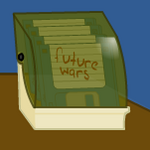 | animal | Future Wars was an adventure game for DOS, Atari ST, and Amiga released in 1990. It was Delphine Software's debut and first attempt at a graphic adventure game with a point-and-click interface. A right click brings up the verb menu. After choosing one of the six commands, point the mouse over the desired target and execute with a left click. The main character is a common window cleaner who finds a time machine in his chief's back office. Thus begins the adventure in both the past and the future. Evil aliens, beautiful girls, and sometimes very frustrating puzzles make up the bulk of this game. | MobyGames GameFAQs Wikipedia |
 | Main Page 22 | The Oregon Trail was an educational game for DOS, Windows, and Apple II, first released in 1985. It was made by MECC, a company known for making educational games, with The Oregon Trail being its most notable accomplishment. As a covered wagon party of pioneers, the player heads out west from Independence, MO to the Willamette River and valley in Oregon. The first goal is to stock up on provisions, and then, while traveling, make decisions such as when to rest, how much food to eat, etc. It incorporated strategy and planning ahead along with discovery and adventure as well as action (hunting and floating down the Columbia River). It also spawned several remakes and sequels. | MobyGames GameFAQs Wikipedia |
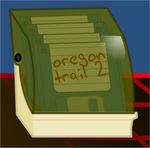 | Main Page 22 | The Oregon Trail II was an educational game for Windows and Apple Macintosh, released in 1995. It was also made by MECC, the second in a line of several remakes of the classic game. This sequel to The Oregon Trail has much more content than its predecessor. Choices of where to travel include Salt Lake City, Sacramento or Oregon City, and starting point are different as well. Many problems arise along the way including starvation, broken appendages, diseases, etc. Party members can be lost because of one of these, but only the player is required to survive to complete the game successfully. | MobyGames GameFAQs Wikipedia |
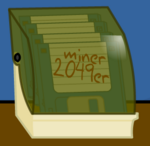 | dreamail | Miner 2049er was an Arcade game created by Big Five Software for PC, Apple II, Atari 2600, Atari 400/800, Atari 5200, Commodore 64, and ColecoVision, released in 1982. Bounty Bob, the main character, is traveling through a mine in search of treasure in a format similar to the classic arcade game Donkey Kong. In this game, however, clearing a level requires walking over all the platforms, which changes their color. To reach all of the floor sections, Bob will need to enlist the help of ladders, elevators, slides, springboards, and even cannons. Collecting artifacts will render him temporarily invincible against the radioactive creatures wandering the mine. Beat all 10 levels to complete the game. | MobyGames GameFAQs Wikipedia |
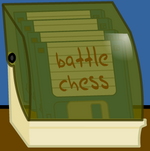 | secret recipes | Battle Chess was a very popular chess program for DOS, Amiga, 3DO, Apple II, Atari ST, Commodore 64, and the NES, released by Interplay in 1988. Instead of the traditional representations of chess pieces, the game featured lifelike representations of the medieval classes the pieces are based on. For example, the pawns are depicted as footsoldiers, the rooks are depicted as golems, and the queen is depicted as a sultry sorceress. Whenever one piece captures another, the game depicts the two pieces engaging in battle. The captured piece meets a gruesome and occasionally hilarious end. The player can play against a friend or against the computer, which offers ten levels of difficulty, the highest of which can give even seasoned chess players a challenge. | |
 | secret recipes | You JERK! is thus far the only floppy disk label not to be software related. It was labeled and then thrown by The Cheat at Strong Bad, in response to Strong Bad offering a recipe on how to cook "The C H E _ T." | |
 | rock opera | Colorado was a historical adventure game for DOS, Amiga, and Atari ST, released by Silmarilis in 1990. The second survival game after Le Fetiche Maya, Colorado casts the player as a fearless adventurer who must deal with the Indians and wildlife while in search of the legendary Cheyenne goldmine. In addition to standard weapons, special objects such as a ship's horn lend an extra level of atmosphere and complexity to the already novel game. | MobyGames |
 | long pants, email thunder | Fiendish Freddy's Big Top O' Fun was a circus activity game for DOS, made by Mindscape in 1989. The game had the player in a circus performing in various acts, such as trapeze swinging and tightrope walking. All the while, he has an evil clown/property developer named Fiendish Freddy trying to obstruct his completion of the event, such as throwing smoke bombs during the knife throw. He does this because with each completion of the event, the player raises money, but if he doesn't raise enough money after all the events, Freddy will demolish the circus to make way for a new office building. | Wikipedia GameFAQs |
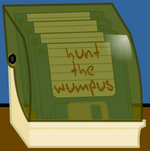 | HomestarRunner.com: PAY PLUS! | Hunt the Wumpus was an early computer adventure game based on a simple hide-and-seek format, originally created as a simple text-based game by Gregory Yob in BASIC, in 1972. Due to its simplicity it has been reincarnated countless times in many different internet sites, palm pilots, mobile phones, and even calculators. A mythical creature called a Wumpus is sleeping somewhere in a series of maze-like caves, and the goal is to hunt it down. The cave is hazardous, with bottomless pits, cave bats, and of course, the Wumpus. If the Wumpus is touched, it will wake up and eat the player. Deduce from clues the location of the Wumpus, and when it seems clear, let fly an arrow! If it's a hit, the game is won, but if it misses, the player is eaten. | MobyGames Wikipedia |
 | garage sale | Typing Tutor Jr was a children's educational game for Windows and Mac, made by Selectsoft in 2001 or earlier. Similar to the fictitious game Typing Tutor by Videlectrix, this game features short and quick lessons developed for kids in order to teach them how to type. It comes complete with a variety of games, and even a poorly named host, "Floater", a spaceman of sorts, to guide through each lesson. | |
 | do over | Marble Craze is a homebrew game for the Atari 2600 designed by Paul Slocum, the same person who was planning on making the Homestar Runner RPG. The concept for Marble Craze arose from the wooden games that have two knobs used to tilt a board, rolling a marble through a maze in an attempt to avoid the holes. To properly simulate one of these games, both paddle controllers are utilized, one to control the vertical movement and the other to control horizontal movement. A simultaneous two-player mode is also available. | AtariAge.com Qotile.net |
 | boring (really) | Karateka was a side scrolling fighting game for DOS, Apple II, Atari 400/800, Atari 7800, Commodore 64, the Famicom, and ZX Spectrum, released in 1986. It was one of the first fighting games ever made. It was programmed by Jordan Mechner, who would later create Prince of Persia. It was published by Brøderbund. The player is a trained master Karateka and has to rescue the princess Mariko from the evil Akuma, who lives in a castle, well-guarded by innumerable fighters. With smooth, realistic graphics that were ahead of its time, it was a visual treat. Unfortunately, it was also quite repetitive, with enemies usually following the same format of attacks. Reaction times to change from one attack move to the next were also slow, making this game enjoyable for some, frustrating for others. | MobyGames GameFAQs Wikipedia |
 | modeling | The Newsroom was a computer program for the Apple II, released in 1985. It was created by the company Springboard, with the premise to create news stories. Among the features was a black and white paint program that allowed insertion of large clip-art sprites as well as saving, loading, and printing finished work. There were also several font sizes, limited page layout options, and even the capability of sending files by modem to other computers running the Newsroom program, even if they weren't Apple II's. | Apple2History.org (image) Apple2History.org (info) |
 | bottom 10 | Wraith most likely refers to a role-playing adventure game for DOS, created by Robert J. Deutsch. The player is trapped in a mysterious mountain cavern, the only companion being an eerie wraith-like ghost who seems to know him. She will taunt the player into venturing ever deeper into the dungeon, but may not be what she appears to be... Wraith uses a snappy mouse-controlled interface with a few keyboard hot keys. | DOSGames.com DownloadGame.com |
 | record book | Crush, Crumble & Chomp was a strategy game for DOS, Apple II, Commodore 64, Atari 400/800, and TRS 80, released in 1981. The main character is a movie-style monster, who can become one of any number of giant crawling, swimming, or flying beasts. Technically this is a strategy game; the player has to keep an eye on several statistics including health, appetite, and even such minute details as the tilt of the main character's head (helps in aiming breath weapons). The goal is to destroy the city before the main character is destroyed. | MobyGames GameFAQs Wikipedia |
 | Real-Live E-Mails | Curse of Ra was an adventure/role-playing game for DOS and the Commodore 64, released in 1982 by Epyx Inc. This was the second in a series of expansion modules for a game referenced in homestar hair, Temple of Apshai. A simple adventure game, the goal is to recover four treasures from four 'great constructs'. This expansion is quite similar to the original game (which is required in order to play the expansion), except that it is set in ancient Egypt. | MobyGames GameFAQs Wikipedia |
 | lady...ing | Genghis Khan was a strategy game ported from various Japanese home computers for DOS, the MSX, Amiga, and the NES, released in 1989 by KOEI. The player assumes the role of Genghis Khan and sets out to conquer and unite Mongolia. It is based on historical facts, such as following the same path of conquest that Genghis Khan did, giving it an edutainment spin. | MobyGames GameFAQs Wikipedia |
 | geddup noise | Low G Man was a side-scrolling action game for the NES, released in 1990 by Taxan. In the year 2284, the human race has perfected space travel and is using robots to colonize the galaxy. Unfortunately, an alien race has captured a planet dedicated to building robots, and reprogrammed them to destroy humans! The player is armed with a wide variety of weapons and a low gravity backpack, giving him the ability to jump higher than normally possible. He can also capture and drive some vehicles after defeating the driver. | MobyGames GameFAQs Wikipedia |
 | geddup noise | Axe of Rage (originally released as Barbarian II: Dungeons of Drax) was an action game for DOS, Amiga, Atari ST, Commodore 64, and ZX Spectrum, released in 1988 by Palace Software. It was the sequel to Barbarian I (or Death Sword). Drax, the wizard villain defeated in the first game, is back. Aided by the princess rescued in the first game, the player must fight through the four levels of dungeons, using various strategies and moves to defeat various monsters, all in a quest to defeat Drax once and for all. Compared to the original, this game is regarded by many to be a disappointment. | MobyGames GameFAQs Wikipedia |
 | Sick Day, Comic Book Movie | Swashbuckler was an action game for the Apple II, released by Datamost, Inc. in 1982. Swashbuckler was a little-known early fighting game. The whole game takes place on the same screen. The main character is in the center and enemies such as humans, snakes, and rats come at him from either side. He has a sword that can strike high, low or center, or block. As the game progresses, the number and speed of the enemies increase until they're too fast for a human to handle, at which point the game is unwinnable. | MobyGames Wikipedia |
 | secret identity | Sam & Max Hit the Road was a fairly popular point-and-click adventure game for DOS, released by Lucasarts in 1993. It was based on Steve Purcell's comic book Sam and Max: Freelance Police. The main characters are Sam (a Canine Shamus) and Max (his "hyperkinetic rabbity-thing" sidekick), a pair of private detectives (or as they prefer to be known, "Freelance Police"). They travel all over the US on the trail of a sasquatch named Bruno who had escaped from the Hall of Oddities at a travelling carnival, and on the way visit locations such as The World's Largest Ball of Twine, The World of Fish, and The Mount Rushmore Dinosaur Tarpit. The game features some of the most twisted humor in a Lucasarts game, and has quickly become a cult favorite. Telltale Games took rights to Sam & Max later on. | MobyGames GameFAQs Wikipedia |
 | technology | Gold Rush was an Adventure game for Amiga, Atari ST, and DOS, released by Sierra Entertainment in 1988. It was exceptional not only for its real-world puzzles and intriguing plot, but also because it was one of the first adventure games to be truly replayable. As a brash young New Yorker setting out to find his lost brother, the players chooses his path to fame and fortune in California from 3 very different ones, each with its own obstacles, dangers and adventure. | MobyGames GameFAQs Wikipedia |
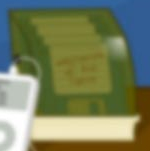 | Podstar Runner | An old version of Podstar Runner showed a floppy container that was too out of focus to clearly read. It seemed to say "_________ of the ____", with the first and last words undecipherable. If this is the case, possible titles include Children of the Atom (A one-on-one arcade fighting game based on the X-Men comics by Capcom for the CPS2 arcade system, the Sega Saturn, the Playstation and DOS), Chronicles of the Sword (A poorly received adventure game based on Arthurian legend for the Playstation and DOS), Defender of the Crown (A revolutionary strategy game by Cinemaware for the Amiga, DOS, NES, Atari ST, ZX Spectrum and the Commodore 64), Defenders of the Earth (A action game based on the 80s action cartoon featuring Flash Gordon, Mandrake the Magician and the Phantom for the Amiga, the Commodore 64, Atari ST, Amstrad CPC and the ZX Spectrum) Discoveries of the Deep (A DOS edutainment game published by Capstone), Footballer of the Year (A soccer game published on various European home computers), and Guardian of the Fleet (A DOS game that simulates the combat systems of a Ticonderoga cruiser). This is also assuming that it followed the recurring theme that the floppy disk has a game title on it, although there was only one time this hasn't occurred. | |
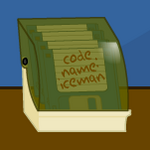 | pop-up | Codename: ICEMAN was a 3rd person adventure game for DOS, Amiga, and Atari ST, published by Sierra in 1989. It was to be the first in an adventure game series, but a sequel never materialized. Navy officer Johnny Westland is the playable character and he takes on a secret mission dealing with the oil reserves in Tunisia. The game is a traditional adventure, with interesting James Bond-esque spy elements. The game had several problems that frustrated players, the most notorious being an overly complex submarine simulator. Other problems included having to complete certain mini-games that depended entirely on chance, and being able to make minor mistakes early in the game, only to find later that the game had become unwinnable. | MobyGames GameFAQs Wikipedia |
 | disconnected, keep cool | Below the Root was an adventure game for the PC, Apple II, and Commodore 64 published by Windham Classics in 1984. The game was based on the fantasy book series The Green Sky Trilogy by Zilpha Keatley Snyder and at the time it featured the largest game world of any adventure game. As a quester, the player assumes the role of a member of the "Kindar", a tree dwelling race, or the "Erdling", an underground race, in an attempt to quell the racial and political tensions building between the races. | MobyGames Wikipedia |
 | alternate universe | Weird Dreams was a "Meditative / Zen" puzzle game for Amiga, Atari ST, Commodore 64, and DOS, released by Rainbird Software in 1989. The plot revolved around a Daemon named Emily trapping the main character in his own subconscious, and he needed to find a way out. With very strange levels including feeding a wasp cotton candy, beating up hopping totem poles with fish from the sky, and an encounter with a baked chicken in a haunted house, Weird Dreams is a surreal, bizarre, and humorous game unlike anything else on the market. May also be a reference to the Email weird dream. | MobyGames GameFAQs Wikipedia |
 | senior prom | Broderbund Classics was likely a collection of the best classic games made by Brøderbund Software, founded in 1980. The company was known for publishing many popular computer games such as Lode Runner, Carmen Sandiego, Myst, and Prince of Persia. The company made progressively more "edutainment" titles throughout its history, ultimately releasing new non-educational games under its Red Orb label, until bought out by The Learning Company in 1998. | MobyGames GameFAQs Wikipedia |
 | redesign | Sundae Drivin' is a driving game by Videlectrix, advertised in 2004, but not yet available for play. According to the product description, the player pilots an ice cream bowl through the streets of Dessertville collecting chopped nuts, chocolate syrup, and cherries. But look out for 18-wheelers and motorhomes and some regular sized cars, too! | Videlectrix |
 | theme song | California Games was a sports game made for PC in 1987, and later ported to Amstrad CPC, Apple II, Atari 2600, Atari ST, Commodore 64, DOS, Genesis, J2ME, Lynx, MSX, NES, Sega Master System, and ZX Spectrum. The game proved to be Epyx, Inc.'s breakthrough game, and featured competitions in several "extreme" sports, including skateboarding, footbag, surfing, roller skating, frisbee, and BMX. | MobyGames GameFAQs Wikipedia |
 | trading cards | The Kyrandia Series of games were an adventure trilogy released in 1992, 1993, and 1994 (both the final game and a three game box set) by Westwood Studios. In Book One: Fables and Fiends Prince Brandon is the main character; a hero chosen to save the land from Malcolm, an evil jester. In Book Two: The Hand of Fate, a royal mystic woman named Zanthia is searching for the anchor stone to prevent Kyrandia from disappearing. In Book 3: Malcolm's Revenge, Malcolm, the evil jester from the first two games, is on a quest both for revenge and proving his innocence. The game features acclaimed graphics, user-friendly interface, good music, and a gentle sense of humor. | MobyGames GameFAQs Wikipedia |
 | cliffhangers | Produced by Cakewalk, (formerly known as Twelve Tone Systems, Inc.) Cakewalk was the name of their flagship MIDI sequencer, first for DOS and since 1991 for Windows 3.0. Early versions of Cakewalk for DOS (up to 3.0) required the intelligent mode of the MPU-401 card and could not be used with today's clones, while later versions (since 4.0) relied on UART mode only. Cakewalk was renamed Cakewalk Pro at some point, and later into Cakewalk Pro Audio when support for digitized audio was added. Cakewalk is ALSO the name of a now very hard to find Atari 2600 game manufactured by CommaVid. | |
 | retirement | MasterType refers to an educational typing program for the Apple II. Originally released by Lightning Software in 1981, later versions were made for the Apple IIe and IIc. "Learn to type by playing a game; simple and ingenious." When the Apple IIc appeared on the scene, the game was updated to teach typing on the optional Dvorak keyboard layout. The scenario used here involved a wizard standing on a planet with satellites or space ships slowly approaching from four directions. Each object had a word on it; the player had to type the word and press the space bar to fire a "zap" at the object. If it got too close, the word had to be typed twice. The IIc version used double hi-res graphics, and both versions allowed the user to set up a personal vocabulary on which to practice. | Apple2History.org |
 | retirement | Silpheed was a 3D ship piloting game, created by Game Arts in 1986. It made its debut on the Japanese PC-8801, released on DOS and TRS-80 CoCo in 1988, and later ported to the Sega CD in 1993. Pilot a spaceship (the Silpheed) through levels of increasing difficulty, in a pseudo-3D vertically scrolling field, shooting everything in sight. New weapons become available as points are gathered, and power-ups are sprinkled throughout the levels. | MobyGames GameFAQs Wikipedia |
 | the chair | BioForge was an action adventure game for DOS, released by Origin (now owned by Electronic Arts) in 1995. The player takes on the role of a cyborg called Lex (Experimental Unit AP-127) who awakens in a cell on a Moon research station with no prior memories. After escaping the cell, the player seems to be one of the scant survivors of the incident that has devastated the station. He must unravel the truth about himself, the research station, the bizarre Mondite cult that controls it, and the mysterious ancient alien race that once inhabited the moon. | MobyGames GameFAQs Wikipedia |
 | what i want | Low Blow was a 3D boxing game released by Electronic Arts for DOS in 1990. As the title suggests, the rules of boxing don't apply in this incarnation, including the rule forbidding punching below the belt. With less than fluid animation and predictable patterns, the game doesn't offer much beyond the short-term comedic value. | Moby GameFAQs |
 | looking old | Drakkhen was a role-playing game originally written for the Amiga and Atari ST by Draconian (later Data East). In 1990, it was ported to MSDOS by MicroProse Software. The player takes on a party of four adventurers travelling to eight distinct castles. Drakkhen was notable for being among the first role-playing games to feature a three-dimensional playing field. The game was eventually ported to the Super NES as an early title for the system. | |
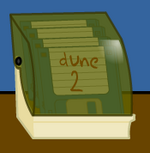 | unnatural | Dune II: The Building of a Dynasty was released in December 1992 for Amiga, DOS, and the Genesis. It is often considered the first modern real-time strategy game and established many conventions of the genre. Even though set in Frank Herbert's famous Dune universe, the game does not follow the plot of any of the books or the movie. It was published by Virgin Games and developed by Westwood Studios. | MobyGames Wikipedia |
 | rough copy | LHX Attack Chopper is a 1990 war helicopter PC simulation game by Electronic Arts. The game was developed by Brent Iverson, a retired U.S. Army soldier. The game was originally for PC-DOS, but versions for other platforms, such as the Mega Drive/Genesis, were also made thereafter. The game had two attack helicopters, as well as two cargo helicopters. It had three different mission scenarios: Libya, Vietnam and East Germany. | MobyGames Wikipedia |
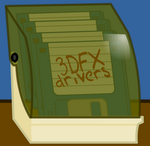 | DNA Evidence | 3dfx was a maker of graphics processing units and graphics cards. It was founded in 1994. In 1996, it released the popular Voodoo Graphics chip, which was originally only sold to manufacturers but soon found its way to home PCs. However, the success of the company started to wane by the end of the decade, and in 2000 the company filed for bankruptcy. It was later bought out by NVIDIA, another graphics card company. | Wikipedia |
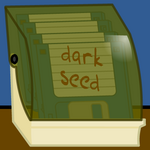 | more armies | Dark Seed is an adventure game developed and published by Cyberdreams in 1992. Originally released for DOS, it was later ported to many other computer platforms. Players control Mike Dawson, a writer who has recently purchased an old mansion in a small town. He dreams that an alien machine has implanted a "dark" seed into his skull, leaving him three days to solve the town's mystery before seed erupts. Dark Seed is notable for its impressive graphics with monsters designed by H.R. Giger of Alien fame but also for buggy programming and frustrating difficulty. | MobyGames Wikipedia |
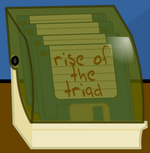 | the paper | Rise of the Triad: Dark War is a first-person shooter video game that was first released for MS-DOS on February 17, 1995. It was developed by Apogee Software (now known as 3D Realms). The shareware version, which contains ten original levels, is titled Rise of the Triad: The HUNT Begins. The plot involves a team of special operatives, known as the H.U.N.T. (High-risk United Nations Task-force), that must stop a cult planning to destroy Los Angeles. Each of the five characters has unique attributes, and the eleven weapons in the game range from an ordinary pistol to a highly destructive "Firebomb". | MobyGames Wikipedia |
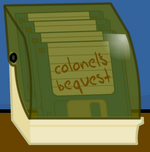 | the paper | The Colonel's Bequest is a computer game published by Sierra On-Line in 1989 for Amiga, Atari ST, and MS-DOS. It was a graphic and text adventure game that was the first of the short-lived "Laura Bow Mysteries" series created by Roberta Williams. The game is set in the 1920s and involves a family gathering in which there are both potential suspects and victims of a murder. Laura Bow, the game's main character, must solve this mystery by discovering information about the characters' backgrounds and relationships. | MobyGames Wikipedia |
 | the paper | Logo is a programming language that was created for educational use. It is heavily based upon the Lisp programming language. Logo was created in 1967 at BBN, a Cambridge, Massachusetts research firm, by Wally Feurzeig and Seymour Papert. It was originally used to make a small robot called the "Turtle" move around according to commands. Later, when the language came to computers, a turtle was used as the cursor. Today there are over 170 implementations and dialects of Logo. | Wikipedia |
 | concert | The Ancient Art of War is a computer game published in 1984 by Brøderbund for the Apple IIe, Macintosh, TRS-80 and DOS. It was a war strategy game in which the player fights battles in a selection of campaigns using squads consisting of combinations of Knights, Archers and Barbarians. Each campaign is contested against a different historical military figure. The hardest enemy is Sun Tzu, whose classic military treatise The Art of War gives its name to the game. The game is considered one of the first real-time strategy games. | MobyGames Wikipedia |
 | original | Secret Weapons of the Luftwaffe (abbreviated SWOTL) is a DOS computer game published by LucasArts. This first-person flight simulation game allowed the user to fly World War II missions over Europe for either side. The user's character gained experience and access to different aircraft with each successful mission. Several of the missions involve supporting or destroying V2 rocket launch sites, which were among the secret weapons of the German air force (or Luftwaffe). LucasArts later produced a sequel named Secret Weapons Over Normandy, though it bears little similarity in terms of gameplay. | MobyGames Wikipedia |
 | pizza joint | D is a survival horror/puzzle game released in 1995 by WARP for the Sega Saturn, Sony PlayStation, 3DO, and PC. The game stars Laura Harris, whose father, a respected doctor, has suddenly and inexplicably gone on a killing spree. It is the first in the D series of games. Although its CGI visuals were impressive for its time, it failed to make much of an impact in the US due to the fact you couldn't save your game or pause during the 2 hours that the game forces you to complete it under. The game is sometimes erroneously referred to as "D's Diner", due to a mistranslation. The Japanese title for the game, "Dī no Shokutaku", literally translates to "D's Dinner Table". | MobyGames Wikipedia |
 | slumber party | Heart of China is an adventure game released in 1991 by Dynamix for the Amiga, DOS and Macintosh. The game stars Jake "Lucky" Master as he rescues nurse Kate Lomax from a Warlord. Heart of China featured multiple endings, and portions of the game were played from the perpective of different characters. Heart of China also featured two arcade-style action sequences. | MobyGames Wikipedia |
 | business trip | Ballistix is an arcade-style game released in 1989 by Psygnosis for the Amiga, Atari ST, Commodore 64, TurboGrafx-16, and DOS. It involves manipulating a ball in order to score a goal against an opponent. By launching balls at correct angles, you can control the movements of the main ball. Gravity and friction are factors in the game, and there are also obstacles to avoid. It features one-player and two-player modes. | MobyGames Wikipedia |
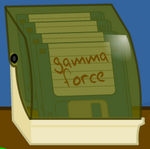 | environment | Gamma Force (in Pit of a Thousand Screams) is a visual novel released in 1988 by Infocom for the Commodore 64 and DOS. In a dangerous world, individual superheroes are not enough. Even the best of them - a humanoid made of flame, an elf princess with a mean bow, and a musclebound waterbeast - can't do it all themselves. When they come together, they are the Gamma Force. Can anybody stop them? | MobyGames |
 | winter pool | 4-D Boxing is a boxing simulation game released in 1991 by Mindscape for the Amiga, Atari ST, DOS, and Macintosh. It aims to emulate the sport with great realism. Its 3-D graphics were very detailed for the time, but it included a stick figure mode for less powerful machines that couldn't support such graphics. Players can create their own boxer and choose between attributes of speed, power, and stamina. Opponents become increasingly difficult as the game progresses. Different tactics such as dodging and counter-attacking can be used to defeat these opponents. | MobyGames Wikipedia |
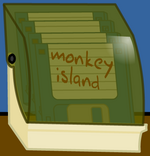 | pet show | Monkey Island is the collective name given to a series of five graphical adventure games produced and published by LucasArts and Telltale Games (for the fifth game). The games follow the misadventures of the hapless Guybrush Threepwood as he struggles to become the most notorious pirate in the Caribbean, defeat the plans of the evil undead pirate LeChuck and win the heart of governor Elaine Marley. Each game's plot usually involves the mysterious Monkey Island and its impenetrable secrets. | Wikipedia |
 | licensed | Return to Zork is a 1993 adventure game in the Zork series for the PC and Apple Macintosh. It was developed by Activision and was the final Zork game to be published under the Infocom label. Unlike the previous games in the Zork franchise, which were text adventures, Return to Zork takes place from a first-person perspective and makes use of video-captured actors as well as detailed graphics; a point-and-click interface replaced the text parser for the first time in a Zork game. | MobyGames Wikipedia |
 | shapeshifter | Relentless is a PC adventure game made by Adeline Software International and first released at the end of 1994. It was also released as Little Big Adventure. The name of the game is an oxymoron. Little Big Adventure is viewed from a pseudo 3D isometric perspective (the game field is rotated 45 degrees). All characters and vehicles in the game, including some props in the world, are real 3D polygon-based objects, allowing for full rotation and movement abilities. | Wikipedia |
 | rated | Mutant League Football was a game developed by Electronic Arts and released for the Sega Genesis in 1993. The game takes place in a post-apocalyptic world where conventional warfare has largely been replaced by an extremely violent version of American football. The players can play on football teams composed of aliens, skeletons, robots, trolls, and super-humans while dodging obstacles such as fire pits, landmines, and holes in the ground that send the players into outer space. | Wikipedia |
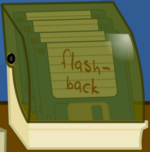 | your edge | Flashback: The Quest for Identity is an action platformer made by Delphine Software in 1992 for the Amiga, and later ported to several other computer platforms and home consoles, making it one of the most widely available games in existence. Players control Conrad Hart, an agent who is working to uncover a conspiracy involving aliens who are posing as humans in society. Similar to Out of this World, also by Delphine, character animation is rotoscoped to look extremely fluid. Gameplay is very similar to Prince of Persia, but with firearms. | MobyGames Wikipedia |
 | magic trick | Rama is a puzzle-heavy first-person adventure game developed and published by Sierra Entertainment in 1996 for Microsoft Windows and Apple Macintosh. Made in collaboration with the authors, it is an adaptation of Arthur C. Clark and Gentry Lee's novel Rama II, and shipped exclusively on three CD-ROM discs. | MobyGames Wikipedia |
 | Strong Badia the Free | First mentioned in virus, Strong Bad has a complete suite of Edgarware software that includes "anti-spam, anti-virus, anti-malware, anti-mail, anti-productivity, and antidisestablishmentarianism software." The floppy disks themselves seem to keep the "P. Quest" label from Homestar Ruiner. | |
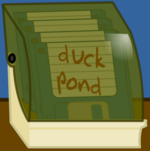 | email thunder | Duck Pond is a duck pond simulator that debuted in the Strong Bad Email duck pond. The Atari 2600 version of the game was Videlectrix's retroactive debut. | |
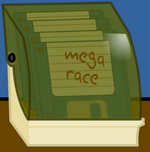 | hremail 3184 | MegaRace was a racing game created by Cryo Interactive in 1994 for MS-DOS, the Sega CD, and the 3DO. Hosted by Lance Boyle, it features virtual reality racing, using various futuristic race cars and tracks. | MobyGames GameFAQs Wikipedia |
 | April Fool 2014 | The name "Eden" is ambiguous, as there are a number of old games with the word in the title. These include: Return to Eden (an interactive science-fiction game for the Amstrad CPC, Atari 8-bit, Commodore 64 and the ZX Spectrum), Eden Blues (an action game for the Amstrad CPC, Atari ST and IBM PC), Amazon: Guardians of Eden (a point-and-click adventure game for DOS) and Lost Eden (a first-person perspective adventure for DOS). | |
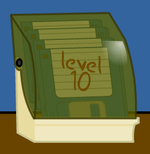 | sbemail 206 | "Level 10" very likely refers to Stinkoman 20X6, whose tenth level had not been released and was considered vaporware at the time of this floppy disk in 2015; the ninth level had been released over 9 years earlier, in 2005. Level 10 was finally released after 15 years in 2020. | |
| | the next april fools thing | Icon: Quest for the Ring is a 1984 game for DOS by Macrocom. Based on the opera Ring of the Nibelungen (itself based on tales from the Norse mythology), ICON: Quest for the Ring is a "dungeon crawler" along the lines of Temple of Apshai, but with fully action-based combat, making it to one of the earliest action RPGs. The player navigates the hero through top-down environments heavily populated by hostile creatures. Standing near the enemy and pressing the attack button will make the protagonist swing the equipped melee weapon; ranged attacks require an additional directional key to execute. | MobyGames |
 | @StrongBadActual tweet (20 Nov 2020) | The Three Stooges is a minigame collection originally released by Cinemaware in 1987 for the Amiga, and later ported to other consoles, including the Commodore 64, NES, and MS-DOS. Based on the comedy trio of the same name, it follows the attempts of Moe, Larry, and Curly to raise money to save an orphanage from being foreclosed by taking on various odd jobs in minigames based after the Stooges' films. The game was praised by critics for its graphics, sound, and humor, but criticized for its shallow and repetitive gameplay. | Wikipedia |
 | Talkin' Strong Bad Plush Doll Commercial | Trogdor Financin' is written on the front of a 5.25" floppy disc. Details of the program are unknown, beyond the fact that it presumably involves Trogdor. | |
 | Disk 4 of 12 - Vampire's Castle | Vampire's Castle is a 1984 game for DOS. It is a short adventure game where the titular vampire's castle must be explored to uncover "concealed goals" and ultimately kill the vampire before midnight. Descriptions in the game are bare, and there are few actions that can be performed. In the commentary for video games, The Brothers Chaps mention it as an influence on Thy Dungeonman, a fact corroborated in-universe when Strong Bad declares it was "definitely" Videlectrix's inspiration for the Thy Dungeonman game. | MobyGames |
